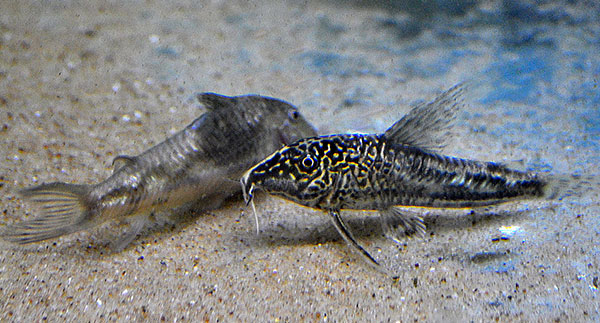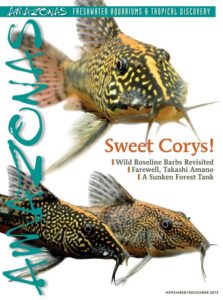
A female (left) and male Bearded Corydoras, better known as Scleromystax barbatus. Image: Matt Pedersen
It’s rare that a fish surprises the AMAZONAS audience, which includes a high proportion of veteran aquarist readers. However, the current issue’s cover models, stunningly beautiful and large “Cory”-type catfishes, definitely caught your attention and had at least one reader asking, “What is that catfish on the cover?!”
Scleromystax barbatus, the Bearded “Corydoras,” is the species behind all the lust!

Cover with three eyecatching Bearded Corys, Scleromystax barbatus, photographed by Hans-Georg Evers. Click to enlarge.
Having kept and spawned Scleromystax barbatus myself, I can attest to their allure and attractiveness. As adults, they are big, in fact the largest Corydoras-type catfish I’ve ever kept, easily reaching about 4″ (100 mm) in length. S. barbatus truly dwarf the fishes that most people visualize when they think of small, cute, and undeniably popular cory cats. Living up to their common name, the males sport patches of bristles on their cheeks. (See uppermost fish on the cover.)
My fish were purchased through an online auction as F4 captive-bred specimens, which I presume may have made them a bit more forgiving than wild-caught counterparts. While recommendations strongly encourage they be kept in the mid-60s F for temperature, I simply kept them in an unheated aquarium towards the floor in my basement fishroom, where tank temperatures were probably ranging between 72F and 76F most of the time.
I recall reading that these catfishes can be somewhat aggressive towards each other, but I never saw any notable problems in my initial 2 male / 2 female group, which shared roughly 15 gallons of tankspace with a 12″ X 24″ footprint, the bottom substrate being fine sand.
In Duluth, MN, I’m blessed with tap water that’s ideal for soft-water South American fishes (TDS out of my faucet runs around 42 ppm). My group of S. barbatus loved to get a cool water change straight from the hose (throwing in some Chloram-X to handle any chlorine and chloramines). Doing this would always kick the males into high gear, trying to coax a spawn from their female counterparts.
While I certainly started with this species hoping to breed them, I observed a few spawns, but was never fortunate enough to hatch their eggs myself. Ultimately, as fishroom demands shifted, I sent my fishes to live with my fellow editor, Stephan Tanner, in Rochester, MN. Whether as a breeding project or simply a fish to enjoy, I’d highly recommend giving this charismatic species a try.
In honor of this truly stunning catfish, and the interest it generated, it seems only fitting that I share a selection of videos showing off the Scleromystax barbatus, the Bearded Cory.
Piranha Productions – Species Overview of S. barbatus
Julian Dignall – Video of spawning S. barbatus
Chrismore Cories – Another look at the spawning behavior of S. barbatus
https://www.youtube.com/watch?v=Ja0N_TRA2zY
Tonton Etienne – A glimps of very young S. barbatus fry
https://www.youtube.com/watch?v=vYqoeeGTY3U
Thierry France – A look at larger juvenile S. barbatus
Niels Verhoork – A planted aquarium featuring a school of subadult S. barbatus, along with Nannostomus rubrocaudatus, Peckoltia compta, and dwarf Cichlids including Taeniacara candidi and Nannacara aureocephalus
Paul H – Footage of juvenile and adult S. barbatus, presumably in a LFS setting
REFERENCES
Planet Catfish Species Listing for Scleromystax barbatus, the Bearded “Corydoras,”
AMAZONAS Sweet Corys! Issue:
Order a Copy
Subscribe to AMAZONAS



